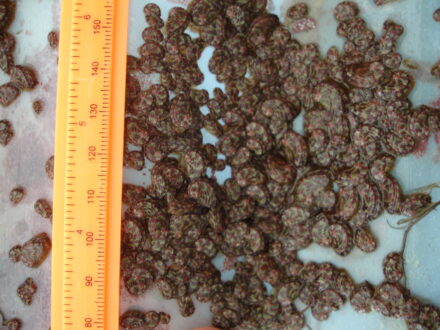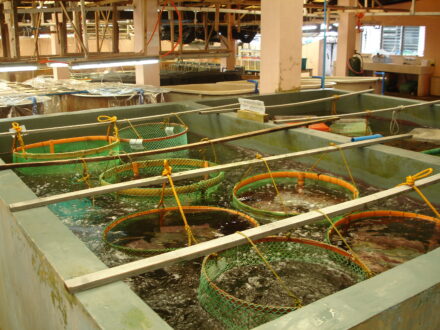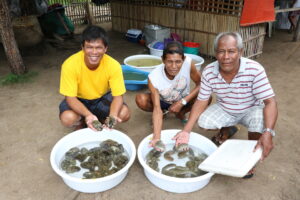Why ABALONE?

Abalone are herbivorous marine gastropods belonging to the genus Haliotis, meaning “sea ear.” There are 100 species worldwide with around 15 species being cultured commercially. It can spawn spontaneously in captivity throughout the year. Abalone are considered a delicacy especially in China and Japan and are in demand in countries like Hong Kong, Australia, Taiwan, Korea and Singapore. The price of live abalone of various species in the international market can range from US$12-120 per kilogram.
The Philippines exported 300 metric tons of H. asinina valued at US$ 1.5 million (NSO, 2012). Haliotis asinina Linne (donkey’s ear abalone, sobra-sobra, kapinan or lapas) is the largest species of abalone found in the Philippines and has been the focus of research and development in SEAFDEC/AQD.
How to culture ABALONE?
Site selection
- Locate culture site away from sources of pollution and ensure availability of clean seawater supply
- Water salinity should range from 28 to 32 ppt
- Site should be accessible to reliable electric power supply, transportation, and communication facilities
- Ensure a reliable source/supply of seaweed Gracilariopsis within the area
Broodstock management
- Stock breeders (either wild or hatchery-bred) in tanks provided with flow-through sand-filtered seawater.
- Feed breeders daily with red seaweed Gracilariopsis heteroclada at 5-10%biomass.
- Practice proper water management and tank maintenance by allowing continuous inflow of sand-filtered seawater, providing strong aeration and cleaning of tanks on a regular basis to avoid growth disruption.
Spawning and post-larval rearing
-

Settlement plates hanging in 1-ton tank Prepare spawning tanks. Fill up a 2 x 1.3 x 1 m (L x W x D) tank with filtered seawater and provide continuous aeration.
- Select mature broodstock. Select healthy breeders from the broodstock tank and place 40-60 breeders with a ratio of 4:1 (female to male) in each spawning tank.
-

Harvested juveniles on settlement plates Prepare incubation tanks. Prepare a separate incubation tank with UV-irradiated seawater, provide moderately strong aeration and airstones.
- Watch out for spawning. Monitor tanks for the presence of spawned eggs between 6:00-7:00 AM.
- Collect eggs for incubation. Collect the newly-spawned abalone eggs that are spherical, dark-green in color and are about 180-200 µm in diameter by siphoning and transfer to incubation tank for 8 hours.
- Harvest larvae for stocking. After incubation, siphon and count larvae from incubation tanks. Determine the total number of larvae by multiplying the average number of larvae per ml to the total volume of water in the tank.
- Prepare settlement tanks. Line the bottom of the settlement tank with corrugated polyvinyl plates (30 x 40 cm) previously colonized with crustose coralline algae and diatoms.
- Stock larvae. Stock the larvae collected into the settlement tanks at a density of 250,000-300,000 per ton of water.
- Allow larvae to settle and transfer to larval-rearing tanks. After 24 hours, collect the polyvinyl plates and transfer them to larval-rearing tanks where the plates should be hung vertically from horizontal poles.
- Repeat steps 7 and 9. Using additional polyvinyl plates, allow the rest of the larvae to settle. Do this for 3 to 5 days until all have settled.
- Feeding larvae and early juveniles. Harvest and feed diatom slurries to larvae and early juvenile every other day or when settlement plates have become devoid of algae.
- Harvest early juveniles. After 90 days, harvest early abalone juveniles with a shell length of 10-15 mm for nursery-rearing.
Nursery-rearing
- Intermediate nursery is the rearing of 10-15 mm shell length early juvenile to 25-30 mm advance juvenile needed for grow-out culture. Normally, the rearing period is from 75 to 90 days in outdoor tanks and from 60 to 75 days in sea cages.
- Feed the juveniles until satiation with seaweeds or SEAFDEC/AQD formulated feed during times when seaweed supplies are low.
Grow-out
-

Abalone grow-out cages suspended in tanks Hatchery-reared abalone juveniles (25-30 mm) can be grown in cages suspended in tanks and in floating net cages in sheltered coves fed with seaweed Gracilariopsis.
- They can grow to a marketable size of 50-60 mm within one year, faster than the temperate species.
Community-Based Resource Enhancement

Abalone (Haliotis asinina) used to thrive in the intertidal flats of Molocaboc Island, the multi-use zone of the Sagay Marine Reserve. However, it was overfished due primarily to its high gourmet value. In 2006, SEAFDEC/AQD with funds from the Japan Trust Fund initiated a Community-Based Resource Enhancement (CBRE) Project in Molocaboc. Abalone breeders from the protected reef areas of SMR were collected and conditioned in AQD hatcheries. Tagged hatchery-bred juveniles were released in the coralline intertidal flats in Molocaboc in 2011, and protected through community education and local catch-size regulation (>6cm shell length harvest size).
The successful collaboration between the fisherfolks, local government and SEAFDEC/AQD has led to increased sales of abalone in local buying stations. Proceeds from the abalone harvests benefit not only the locals but have even provided operational funds for their fisherfolk organization that manage the CBRE site and protect the coastal environment. Local gleaners attest to collecting more abalone in rocky areas outside the release site which manifest in increasing sales of abalone in local buying stations.
This CBRE Project has demonstrated that hatchery-bred juveniles released in suitable protected sites can enable rebuilding depleted coastal resources; supplement livelihoods; and contribute to improving the supply of abalone in local and export markets.
Why stock abalone, Haliotis asinina?
- indigenous but overfished in many areas in the Philippines
- high-value species targeted by fishers for cash income
- high-demand gourmet export commodity
- threatened species identified for stock enhancement by SEAFDEC/AQD
- SEAFDEC/ AQD has hatchery, nursery, tagging, transport and release technology
Reference:
SEAFDEC Aquaculture Department. (2017). Abalone culture [Brochure]. Tigbauan, Iloilo, Philippines: Author.
Need ASSISTANCE?
Get a copy of our publications!
 |
Abalone Culture (2017) The brochure contains information on the hatchery and grow-out culture of abalone.
|
 |
Abalone culture poster 20.32 X 30.48 cm [3.55 MB] Conceptualized by |
Attend our hands-on training!
Abalone Hatchery and Grow-out training course at AQD’s Tigbauan Main Station.
 |
| View training brochure |
To apply, kindly contact:
Training and Information Division
(63-33) 330 7033
[email protected]
Check out our training schedule: www.seafdec.org.ph/training
 SEAFDEC/AQD Southeast Asian Fisheries Development Center | Aquaculture Department
SEAFDEC/AQD Southeast Asian Fisheries Development Center | Aquaculture Department